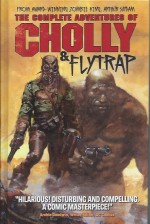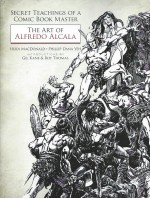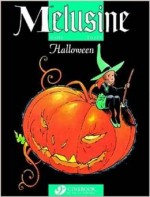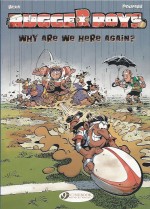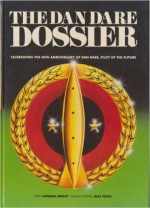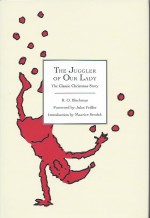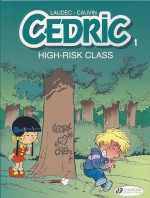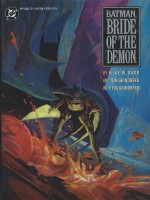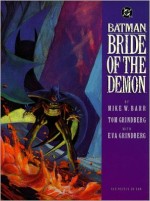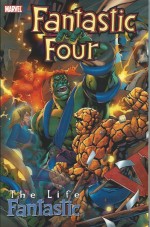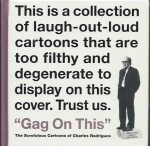
By Charles Rodrigues, edited by Bob Fingerman (Fantagraphics Books)
ISBN: 978-1-60699-856-4
Win’s Christmas Gift Recommendation: Sick, Sick, Sick – the ideal antidote to Seasonal Saccharine Overload… 9/10
Charles Rodrigues (1926-2004) is one of the most influential – and certainly most darkly hilarious – American cartoonists of the last century, but when papers and periodicals began abandoning en masse the grand tradition of spot gags in the 1980s he and his illustrious compatriots began to fade from cultural consciousness. Now it seems almost nobody remembers him but thankfully companies like Fantagraphics are doing their bit to recall and immortalise him and them…
Rodrigues’ surreal, absurd, insane, anarchic, socially disruptive and astoundingly memorable bad-taste gags and strips were delivered with electric vitality and galvanising ferocity in a number of magazines. He was most effective in Playboy, The National Lampoon (from the first issue) and Stereo Review – the pinnacle of a career which began after WWII and spanned nearly the entire last half of the 20th century in every type and style of magazine.
After leaving the Navy and relinquishing the idea of writing for a living, Rodrigues used his slice of the G.I. Bill provision to attend New York’s Cartoonists and Illustrator’s School (now the School of Visual Arts) and in 1950 began schlepping gags around the low-rent but healthily ubiquitous “Men’s Magazine†circuit.
He gradually graduated from girly-mags to more salubrious publications and in 1954 began a lengthy association with Hugh Hefner in his revolutionary new venture, whilst maintaining his contributions to what seemed like every publication in the nation buying panel gags: Esquire to TV Guide, Genesis to The Critic.
He even found time to create three strips for the Chicago Tribune-New York News Syndicate – Eggs Benedict, Casey the Cop and Charlie.
The quiet, genteel, devout Catholic’s lasting monument and undisputed magnum opus, though, was the horde of truly appalling sick, subversive, offensive and mordantly, trenchantly wonderful one-offs he crafted on a variety of favourite themes for The National Lampoon, whose editor Henry Beard sought him out in the earliest pre-launch days of 1969, and offered Rodrigues carte blanche, complete creative freedom and a regular full-page spot.
He stayed aboard from the 1970 debut until 1993, a mainstay of the legendary comics section with sickeningly brilliant results which were recently compiled preceding edition Ray and Joe…
Here bracketed by a copious and informative biography by Editor Bob Fingerman and a heartfelt ‘Introduction’ by brother-doodler and sometime Cartoon Editor at the shockingly indulgent Lampoon Sam Gross, this monumental monochrome collection – presented as a sturdy hardback digest tome – features a staggering selection of explosively hilarious, wittily twisted visual broadsides gathered into a smart procession of tawdry topics…
After starting out lambasting our most basic drives in ‘Dirty Cartoons for Your Entertainment’ and ‘A Peeping Tome’, focus soon shifts to weird fantasy in ‘Moon Madness’ and contemporary traumatic tropes in ‘Assassin’ before going too far, too soon with some ‘Cartoons Even We Wouldn’t Dare Print’…
Because one can never get enough, it’s quickly back to basics with ‘Cartoons of a Sexual Nature’ after which other appetites are quashed with ‘Cuisine de Machine’ exposing the horrors only automats and vending machines can inculcate whilst ‘Would You Want Your Daughter to Marry One?’ deals with freaks and outcasts at their most intimate moments of weakness…
Some truly outrageous innovations are launched and sunk in a large section devoted to ‘Entrepreneurs’ before controversy is courted – and subsequently walks off with a huge settlement – in ‘Goddam Faggots!’ after which more societal hypocrisies are skewered in ‘Handicapped Sports’ and things get good and bloody in ‘Hemophunnies’.
Rodrigues was blessed (or cursed) with a perpetually percolating imagination and eye for the zeitgeist, so the contents of ‘The Celebrity Memorabilia Gallery’ are truly baroque and punishingly peculiar whereas ‘Hire the Handicapped’ merely offers genuinely groundbreaking solutions to getting the less-able back to work before this selection of Good Works concludes with much needed advice on ‘Good Ways to Kill: A Rock Performer!’…
Trenchant observation informs the visual catalogue of ‘Man in Morgue’ but it’s just sheer bad taste in play with follow-up chapter ‘Man in Toilet’ and macabre relationship counselling for ‘Men’s Liberation’ (in dealing with wives or mothers).
At the halfway stage of this colossal collection there’s time for ‘More Handicapped Sports’ before poking fun at the blind in ‘Out of Sight’, exploring the particular wrinkles of ‘Senior Sex’ and dutifully re-examining ‘The Seven Deadly & Other Sins’ – which you will recall include Pride, Envy, Anger, Covetousness, Lust, Sloth, Gluttony, Anti-Colostomyism, Conformity, Vomitry, Bitchiness and Dalmatianry – and then galloping off at a strangely artistic tangent to present ‘Sex Cartoons Drawn With a Hunt Pen’…
Scenes (never) overheard at the ‘Sex Change Clinic’ naturally segue into an itemised itinerary of disasters involving ‘Sex Robots’ and naturally culminate in ‘More Cartoons Even We Wouldn’t Dare Print’ and another period of play for ‘Handicapped Sports’…
All aspects of human misbehaviour appealed to Rodrigues’ imagination and many are featured in ‘Sexentrics’ and its playful sequels ‘Sexports’ and ‘Sleazy Sex Cartoons’, all of which quite naturally lead to ‘Life on Death Row’…
Unwholesome variety (and a penchant for conspiracies) is the spice of ‘A Group of Cartoons Requested by S. Gross’ before deviating eastwards to expose ‘Soviet Sex’ and heading back to jail to walk ‘The Last Smile’.
Shambling into the hilarious last lap we endure some ‘Tough Sex’, show ‘Cartoons About the Blind (The Kind They Wish They Could See)’ and get gritty in ‘Sons of the Beaches’ before heading to the ‘…Circus!’ and ending everything with ‘Those Darned Serial Killers!’…
These horrific and hilarious assaults on common decency celebrate and commemorate a lost hero of popular cartooning and consummate professional able to turn his drawing hand to anything to get the job done. This is another astoundingly funny gag-art grimoire brilliantly rendered by a master craftsman and one no connoisseur of black comedy will want to miss.
This edition © 2015 Fantagraphics Book. All strips and graphics by Charles Rodrigues © Lorraine Rodrigues. Introduction © 2015 Sam Gross. Biography © 2015 Bob Fingerman. All rights reserved. This edition © 2011 Fantagraphics Books.

